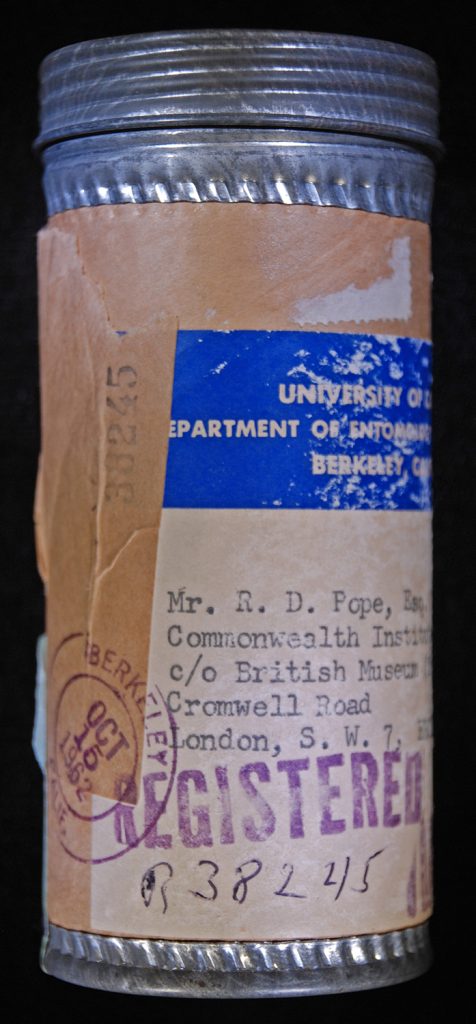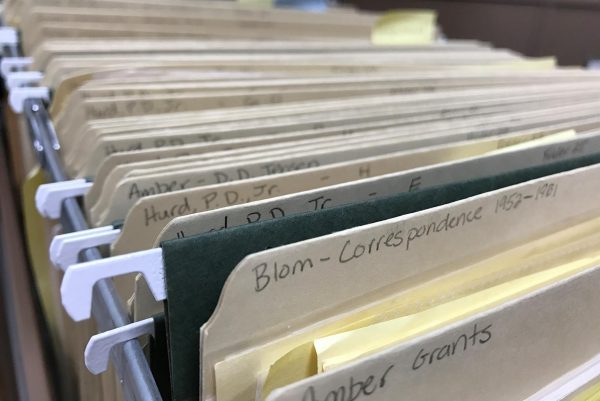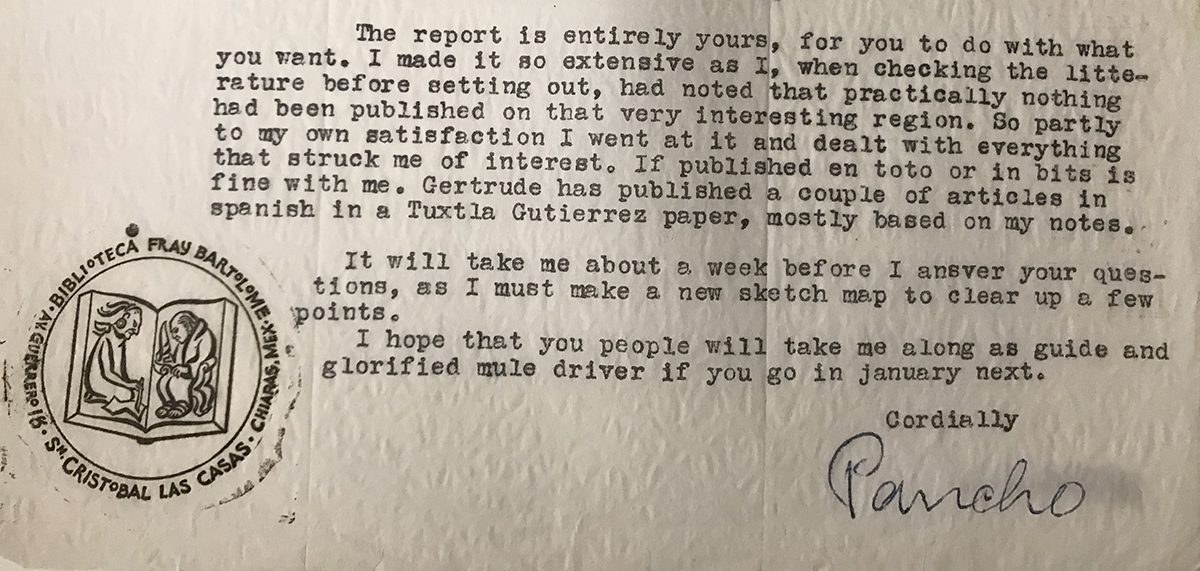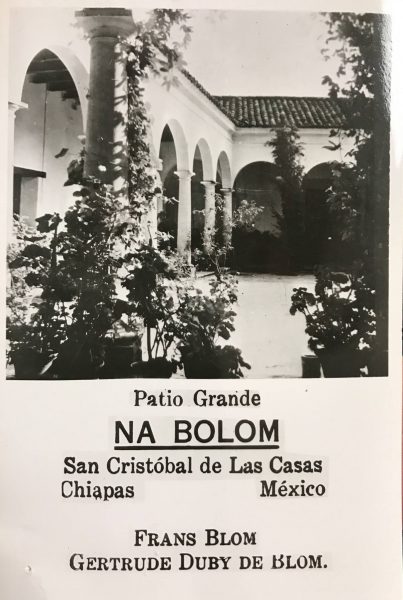There is always more to science than just science
By: Marwa W. Ibraheem
It is hard to walk down the aisles of the University of California Museum of Paleontology (UCMP) without feeling that overwhelming adventurous vibe. These exquisite collections may seem still now, tucked safely away in cabinets, tagged and numbered in tidy and well-organized storage units, however, just looking at them will instantly spark one’s imagination as they attempt to visualize them in the field from where they were collected. The little tags they carry provide so many important details about what they are, where they’re from, how old they are, when they were collected and by whom.


One of the most significant collections at the UCMP are the insects in amber. It includes amber specimens from different locations around the world, the largest number coming from Chiapas, Mexico. These specimens along with other fossil insects at the museum are currently being digitized through the NSF-funded Berkeley Fossil Insect PEN (BFIP). While working on the project, the BFIP team found that some amber specimens were missing, many having been sent out decades prior on loan to researchers around the world. It was time now to turn to the amber files to see if we could glean clues from these documents to track down their whereabouts, and hopefully repatriate them back into the collection so they, too, could be imaged.
The amber archive files as described on the UCMP’s blog by Lucy Chang include 85 folders numbered and arranged alphabetically based on their contents of letters, receipts, manuscripts, maps and photos. Much of the material includes letters exchanged between UC Berkeley professors in the former Departments of Entomology and Parasitology, and Paleontology, and their colleagues worldwide. In a general sense, the letters were every day typical scientific correspondences, requesting specific specimens for loan (or returning them), inquiring about funding possibilities or collaboration opportunities and/or exchanging manuscripts before and after suggested modifications. The one remark about the letters is how proficient the professors conducted their scientific work, the articulate language they used, the “vintage” stationary, the stamps and wonderfully prompt mailings given the state of postal services at the time.
One mail “thread”—as we would call it nowadays in our world of email—in folder 19 strongly stood out and drew my special attention. It was coming to UC Berkeley right from the heart of Mexico (Chiapas). The mail thread’s back and forth letters were exchanged over the course of a decade (1952–1962) between three of our renowned professors here at Berkeley: J. Wyatt Durham, Ray F. Smith and Paul D. Hurd, and the legendary Mayan explorer Frans Blom in Cristobal, Mexico.


Frans Blom, a daring Danish Mayan explorer born in 1883 to a wealthy family, lived such a revolutionary life as an archaeologist and as a man. He left it all behind in Denmark and headed to America in 1919. Soon after arriving in the United States he moved to Mexico to work for an oil company, a position he left later on to pursue his studies and explorations of Mayan archaeology. Despite Blom’s numerous contributions to the history of Mayan civilization, only his 1928 expedition received much attention. He possessed an unintentionally haunting dominating presence that reflected in his letters in a very exciting way. Adding to his debonair persona he became known as Don Pancho or Pancho.
From the first glimpse one definitely recognizes that there is absolutely nothing ordinary about his letters. And it is not just that they are full of rich professional details that outline the adventurous expeditions that the professors led with the great guidance, support and careful planning and arrangements of Blom, but were written in the most literary yet spontaneous non-scientific language I have ever read. Pancho vividly writes himself down with every word to the degree that the letters turn into his own reflection.

 Pancho settled in San Cristobel, Mexico in 1950, where he and his wife Gertrude (Trudi; a professional photographer) bought a house (casa). They called it Casa Na Bolom (House of the Jaguar), the name inspired from the fact that Blom and Bolom (‘jaguar’ in the Tzotzil language) are pronounced similarly. Due, in part, to growing financial concerns, as was mentioned by Blom to Professor Hurd in 1952, the house was converted by adding rooms and an adequate library to serve as a hotel for special guests and a research center for scholars and researchers during their expeditions and field work. Blom’s sister often referred to Casa Na Bolom as a madhouse and Blom’s visitors as ‘inmates.’ Blom, aside from his Mayan exploration adventures had an agreement with UC Berkeley professors in 1955 to manage and arrange for their amber collection expedition in 1956, and the short visits that followed within the framework of the “Forever Amber” project as the professors and Blom called it. The preparations included setting schedule, drawing maps, providing hosting details, hiring pack animals and muleteers and securing provisions and reservations. Blom also had carefully and promptly adjusted the plans given the earthquake and the landslide that occurred in November, 1955, just in time before the actual trip took place in January, 1956. On October 6, 1957, Hurd sat down with “The University Explorer” broadcaster Hale Sparks for a program called “Forever in Amber” to talk about amber, its formation, the inclusions, and the Chiapas amber project.
Pancho settled in San Cristobel, Mexico in 1950, where he and his wife Gertrude (Trudi; a professional photographer) bought a house (casa). They called it Casa Na Bolom (House of the Jaguar), the name inspired from the fact that Blom and Bolom (‘jaguar’ in the Tzotzil language) are pronounced similarly. Due, in part, to growing financial concerns, as was mentioned by Blom to Professor Hurd in 1952, the house was converted by adding rooms and an adequate library to serve as a hotel for special guests and a research center for scholars and researchers during their expeditions and field work. Blom’s sister often referred to Casa Na Bolom as a madhouse and Blom’s visitors as ‘inmates.’ Blom, aside from his Mayan exploration adventures had an agreement with UC Berkeley professors in 1955 to manage and arrange for their amber collection expedition in 1956, and the short visits that followed within the framework of the “Forever Amber” project as the professors and Blom called it. The preparations included setting schedule, drawing maps, providing hosting details, hiring pack animals and muleteers and securing provisions and reservations. Blom also had carefully and promptly adjusted the plans given the earthquake and the landslide that occurred in November, 1955, just in time before the actual trip took place in January, 1956. On October 6, 1957, Hurd sat down with “The University Explorer” broadcaster Hale Sparks for a program called “Forever in Amber” to talk about amber, its formation, the inclusions, and the Chiapas amber project.
 In his own words Don Pancho would use phrases like, “Are you nuts or you got a hell-icopter…I hit the ceeling [sic] when I read your schedule,” in reply to a logistically unrealistic field trip schedule and plan proposed by one of the Berkeley professors. Which in reply, Professor Hurd wrote back saying “It is quite evident from your letter that you have me pegged as one of those stuffed shirt jokers and you may be quite right. At any rate, your opening sentence leads me to believe that the ideal itinerary, which we proposed cannot even begin to be consummated.” The two became more than friends later on. Blom would also inquire about a new correspondent by asking, “Who is this bird?,” while attaching the correspondent’s letter as a reference. Or expressing his dismay in writing using choice words like “Damit,” that the native workers were throwing away amber pieces with inclusions thinking that they were flawed. Or describing out of impatience his finally-sent report as “darned.” And jokes about the received funds writing, “I can assure you, though, that we didn’t spend any of it on nightclubs.” And in describing the scene of the November, 1954 Simojovel earthquake he didn’t forget to mention that, “The Padre in Yajalon was hit on the back by a fallen bit of a cornice and everybody is sorry that it did not hit him on the head.” He had such a great sense of humor in the most unexpected way, as you read through this history you cannot help but laugh.
In his own words Don Pancho would use phrases like, “Are you nuts or you got a hell-icopter…I hit the ceeling [sic] when I read your schedule,” in reply to a logistically unrealistic field trip schedule and plan proposed by one of the Berkeley professors. Which in reply, Professor Hurd wrote back saying “It is quite evident from your letter that you have me pegged as one of those stuffed shirt jokers and you may be quite right. At any rate, your opening sentence leads me to believe that the ideal itinerary, which we proposed cannot even begin to be consummated.” The two became more than friends later on. Blom would also inquire about a new correspondent by asking, “Who is this bird?,” while attaching the correspondent’s letter as a reference. Or expressing his dismay in writing using choice words like “Damit,” that the native workers were throwing away amber pieces with inclusions thinking that they were flawed. Or describing out of impatience his finally-sent report as “darned.” And jokes about the received funds writing, “I can assure you, though, that we didn’t spend any of it on nightclubs.” And in describing the scene of the November, 1954 Simojovel earthquake he didn’t forget to mention that, “The Padre in Yajalon was hit on the back by a fallen bit of a cornice and everybody is sorry that it did not hit him on the head.” He had such a great sense of humor in the most unexpected way, as you read through this history you cannot help but laugh.


Real friendships developed between Blom and UC Berkeley’s entomology and paleontology professors, especially with Professor Paul Hurd and his family; Grace (wife) and Kathy (daughter). Such friendship was displayed in so many ways like when Blom decided Paul shall be called “Don Paplo” during a trip, and when Blom sent him a jaguar claw and wrote: “an insignia given only to sons who have been on a field trip with the Blom Trudi and Na Bolom combination.” Such genuine friendship that would back Hurd up when he sent a letter to Blom asking about the possibility of him and Professor Ray Smith coming for 2–3 weeks in the summer of 1962 and writing: “Doubtless your reaction will be: “those crazy Berkeley Professors” since, as I recall, this is what you felt about our proposed mule train trip in search of amber” referring to Blom’s “hell-icopter” comment.

Blom and Trudi were also always keen to send postcards and photos that feature him, his family and their close friends in Casa Na Bolom, stamped or decorated by the lovely jaguar logo of the house. They would talk about social and native environment and events along with extraordinarily beautiful postcards, photos and hand drawn maps. And just like a novel would go, the social life of the families was also a sweet line to follow up with as the wives exchanged regards, warm invitations and constant efforts in providing charity supplies for the natives in need.
Blom, Pancho or Don Pancho lead a daring life, gave few worries to his financial status or health conditions, but unfortunately, as mentioned in the literature, he had two addictive bugs; liquor and cigarettes. So, as in any novel there is always an ending, the reader can feel the energy in the letters fade, Pancho starts signing them as “Mol Pancho,” which he then explains “Mol = Old, Pancho, as the Indians here now call me. Fine.” In those letters he would describe his health status and the treatments he received like in November, 1957 when he wrote “My heart condition is fine. Dr. Cesarman of the Mex. Heart Institute used me as an experimental guinea pig, trying out a new medicine, not on the market yet, and this has worked wonders I feel better than in many years, take horseback rides to get back in training for the field.” Then, as feared, a date came when a letter arrived without Blom’s “most cordially” hand written signature “Pancho.” That date is June, 1963, but the Casa Na Bolom is still serving the same mission as a hotel and center for researchers to this day.

Not only did Blom co-author and publish several books, but also his full life in Mexico was, to our good fortune, beautifully documented by many photos taken by his loving, talented wife Trudi, who published a few books herself covering the social side of the natives’ lives in a very exclusive sincere way. Her books included many photos of Blom in the house and during field work. There are several letters in the folder that are addressed to and written by Trudi, as Trudi also did part of the corresponding with the professors in times when Pancho was out in the field.

It is also worth mentioning that Blom’s priceless expedition memoires/diaries, field notes, photographs, maps and other belongings are distributed between his house (Casa Na Bolom) in Chiapas, Mexico, Middle American Research Institute, Tulane University, Bancroft Library, UC-Berkeley and the entirely different collection of amber specimens, letters copies and hand-drawn maps at the UCMP. In addition to other resources that were mentioned in the Explorer`s biography written by Brunhouse in 1976, these include; Brigham Young University, Free Library of Philadelphia, New York Public Library, University of Pennsylvania, University of South Alabama, and University of Texas.

That being said, our archival Frans Blom amber files, despite their limited time and size range, is a unique resource, especially one that covers the last decade of Blom’s colorful history, and the crucial role he heroically played in the “Forever Amber” quest.

Photograph: Gertrude Duby Blom/Courtesy, ©Asociacion Cultural Na Bolom A.C.
Reading about him or navigating through the online reference materials feels nothing like actually holding in your hands the papers he once held — hearing him whisper aloud the words as he would type them, grumbling or giggling with every keystroke. His overlooked history was thoroughly presented in two publications: Frans Blom Maya Explorer (1976) by Robert L. Brunhouse and a more recent biography by historians Tore Leifer, Jesper Nielsen, and Toke Sellner Reunert (2003), the title alone “Restless Blood,” indicates how this book perfectly captures the Blom that I got to know working with his UCMP archives.